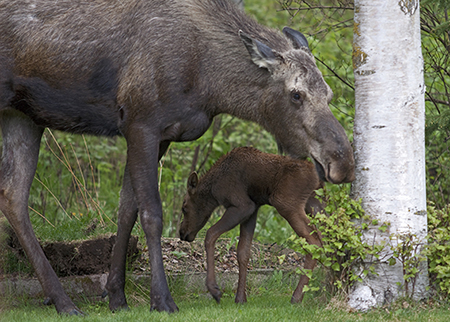Alaska Fish & Wildlife News
June 2024
Cubs, Calves, & Fawns
Leave wildlife alone

Newborn moose calves, deer fawns, and bear cubs are appearing in Alaska. Biologists are warning Alaskans who may encounter newborn wildlife to resist the urge to approach or “rescue” them.
Cow moose can be especially dangerous during calving season, and attacks on people (and their dogs) by mother moose vigorously defending calves are reported each spring. In mid-May this year a cow moose with twin days-old calves killed a man near his house in Homer. A few weeks later a moose calf approached a man on a trail behind his house in Chitina, and before he could respond the mother charged him, leaving him with multiple broken bones.
If you come across a moose calf or bear cub and don’t see its mother, be alert. You may have walked between the mother and her young. Back away and leave the way you came. Do not assume young animals found alone are orphaned. Mother moose and bears frequently walk out of sight, cache their young, or become separated from them by fences or roads. Mother bears often send cubs up trees to wait before leaving to find food. In nearly all cases, the mothers return to their young.
Sitka Area Biologist Stephen Bethune said black-tailed deer mothers stay away from their newborn fawns to avoid drawing predators.
“Does will cache them for several hours while they go off and feed,” he said. “It’s a strategy. It’s safer for the fawn to not be with the doe while she’s feeding. It’s not orphaned, and its mother is likely nearby.”
He added that if you find bear cubs by themselves, it is best to leave the area immediately. The sow is likely nearby and may fiercely protect her cubs if you approach them. For deer it is more about safety for the animal, with bears (and moose) it is more about safety for the person.
Paul Converse in Douglas said every spring, the Southeast office receives calls about birds, young porcupines, and especially black-tailed deer fawns.
“There have been instances where people have picked up and tried to care for a deer fawn,” he said. “A few years ago we learned a woman was taking care of an otter.”
He appreciates that people are well-intentioned but wishes they would not put themselves in these roles. “Please leave them alone and contact Fish and Game if you are concerned.”
It’s tempting to feed or “help” young animals near your home or in your neighborhood. It’s best to just leave them alone. We can be good neighbors to wild animals that live in areas adjacent to homes by leaving them alone - we don’t want them to become overly accustomed to our homes, yards and outbuildings. Animals like mink, otters, marten and squirrels can be very destructive.
Biologist Tony Hollis said the Fairbanks office gets a few calls about moose calves each year, “but a majority of the issues are with the public bringing in young birds, hares, squirrels, and fox pups in a box and asking us what to do with them.”
“They might be abandoned, but probably not and they have a better chance out there,” he said.
Even when young animals truly are orphaned it’s best to leave them alone. Don’t attempt to feed or pick them up; this type of contact with animals is illegal and could result in a citation and fine. Lingering near or approaching a young animal for a photo may discourage the mother from returning.

Bicyclists and runners should be especially alert as they can swiftly top hills or round corners and run into moose, bears and other wildlife. Making noise to alert wildlife to your presence is always a good precaution but may not be enough when speeding down a trail to avoid clashes with moose cows with calves. Newborn moose calves aren’t able to run from predators – or from pets or people on bicycles, and mothers are likely to stand their ground, even when they hear you coming.
Running and Biking in Bear Country
Some diseases, such as rabies, are transmitted to people by animals. If you see an animal that looks sick or that is behaving abnormally, contact Fish and Game.
If you observe a young animal that appears to have been left alone for more than 48 hours, contact the nearest Alaska Department of Fish and Game office during regular business hours, or use the department’s smartphone-friendly link to file a report online by visiting http://www.adfg.alaska.gov and clicking the “Report a Wildlife Encounter” button. If a situation involves an immediate public safety concern, call 9-1-1.
More information on "distressed" wildlife.
AFWN Article: Kicking and Stomping - Moose hooves are formidable defense
Area Contacts
Anchorage, Cory Stantorf, 267-2811, cory.stantorf@alaska.gov
Soldotna, Nick Fowler, 260-2960, nick.fowler@alaska.gov
Juneau, Carl Koch, 465-4329, carl.koch@alaska.gov
Sitka, Steve Bethune, 747-8449, stephen.bethune@alaska.gov
Fairbanks, Tony Hollis, 459-7256, tony.hollis@alaska.gov
Nome, Sara Henslee, 443-8191, sara.henslee@alaska.gov
Palmer, Chris Brockman, 746-6325, chris.brockman@alaska.gov
NOAA fisheries responds to entangled marine mammals. Please communicate with trained responders if you see an entangled whale.
Call the Alaska Marine Mammal Stranding and Entanglement Network 24/7 hotline at (877) 925-7773. Call the U.S. Coast Guard on VHF Channel 16
Subscribe to be notified about new issues
Receive a monthly notice about new issues and articles.
